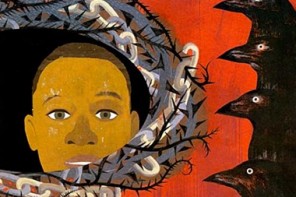Vanity Fair is running an on-line extra this month about the latest crop of Jewish writers, and their place in the history of modern Jewish letters. David Sax, who has his own book coming out about the history of the Jewish deli, argues that celebrated young authors like Michael Chabon, Nicole Krauss, Jonathan Safran Foer, and Nathan Englander be collectively dubbed “the New Yiddishists.” He sidesteps the fact that none of these talented people write in Yiddish, let alone speak it. This is significant.
The only Yiddish writer mentioned in the piece is Nobel laureate Isaac Bashevis Singer, who is one of the only Yiddish writers that most people have heard of. (Most other Yiddish writers hated him for his success, as depicted in Cynthia Ozick’s thinly-veiled short story “Envy, or Yiddish in America.”[pdf]) And Sax’s invocation of Singer is rather clichéd, reducing the extensive and nuanced oeuvre to “tales of young rabbis in Russian shtetls.” (It’s nit-picking to point out that Singer was from Poland, but I couldn’t stand the itch.)
The other writer that features prominently in Sax’s analysis is Philip Roth. Sax seems to be proposing that the distinctive feature of today’s Jewish writers is a kind of return, through Roth, to Singer. Whereas Roth, Saul Bellow, and the other masters of the mid-to-late 20th century, struggled vigorously and painfully with their Jewishness, and envisioned salvation as residing in the arms (a euphemism) of shiksas, the “New Yiddishists” are relatively unencumbered and have no compunction about using elements of Jewish life, culture, and history as both text and subtext. Sax, or whoever slapped the subheadings on his article, calls this “reverse assimilation.”
It might be more accurate to say that the kind of piecemeal, whimsical, and nostalgic re-appropriation of Jewishness that occurs in the works of many of these writers is not any kind of reversal of assimilation, but its natural extension. It’s a fairly familiar ethnic American story that the generation with thick accents gives way to a generation of strivers, who in turn make way for the generation that relexifies the language of the integrated bourgeoisie with the terms of a forsaken ethnicity.
Sax is dismissive of reviewers like William Deresiewicz, who wrote in the Nation two years ago that “the most visible of the current generation of self-consciously Jewish novelists appear to be avoiding their own experience because their own experience just seems too boring,” and further suggested that “American Judaism has long been beset by a deep sense of banality and inauthenticity.” But Deresiewicz is on to something.
Roth’s writing is intensely personal, and, from one perspective, the overarching program of his career has been to write himself into existence—a kind of Promethean/Beckettian task contextualized in the historical experience of 20th century Jewish assimilation. The old Yiddishists, with Singer representing only the tip of the iceberg (“Iceberg, Rosenberg, it’s all the same to me…”) were actually doing something similar, with much higher stakes—furiously engaging with modern literary form to make themselves modern, in the tumultuous period that followed the Emancipation of the Jews.
What is really interesting about Sax’s group, in addition to what they do with Jewishness, is what we see them doing with Jewishness when we take a step back. Foer’s Everything is Illuminated, one of the most feted of the new works, is also the most indicative. The author’s pyrotechnical inventiveness is hitched to an actual plot line that is both historically and personally dishonest, as well as dramatically thin. Foer’s eponymous protagonist journeys in search of the shtetl where his ancestors came from, discovers treasures of history, and finds, too, that the non-Jewish residents are to this day so upset by the slaughter they abetted that they will kill themselves when reminded of it. Its kernel was, apparently, Foer’s failed journey to find his ancestor’s shtetl. And any Jew who has done some kicking around in Eastern Europe knows that remorse and sorrow are not the most salient emotions one experiences in the natives.
Everything is Illuminated is actually a failed novel, but not in the best sense of the term. Doris Lessing’s The Golden Notebook is probably the most successful example of the failed novel, a work that demonstrates the trauma of being unable to bring literary creativity to the desired conclusion, and the kind of dissonance of self and imagination that ensues. Foer’s book has all of the same elements, and yet he decides to force it home. The result is a kind of imaginatively expansive naiveté.
Sax notes that Roth was excoriated by the image-conscious American Jewish community when his work began to emerge. The “new Yiddishists,” who speak, at best, a pidgin version of the intimate old language, have been roundly embraced. The Jewish establishment, facing a crisis of attrition, is overjoyed that these young people chose to engage Jewishness in their work, and is happy to reward them with prizes and fellowships. There is nothing wrong with this, if we can do no better, but as a consequence, a better appellation for the group might be “the new Mentches,” or “the nice Jewish writers.”



